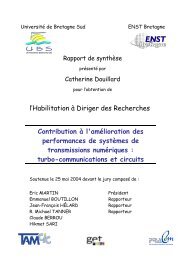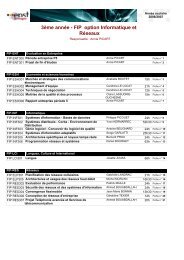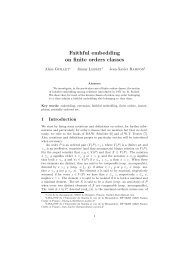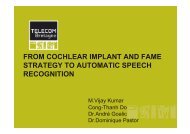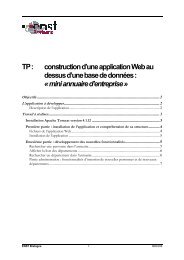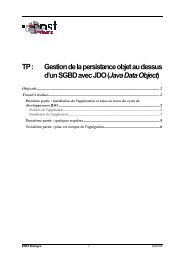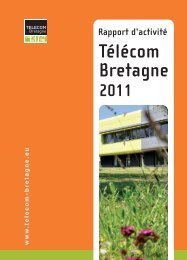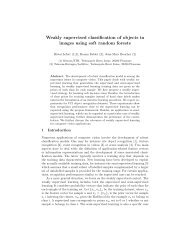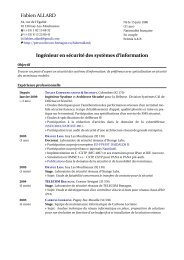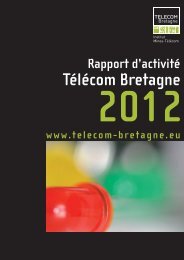researResearch - Télécom Bretagne
researResearch - Télécom Bretagne
researResearch - Télécom Bretagne
You also want an ePaper? Increase the reach of your titles
YUMPU automatically turns print PDFs into web optimized ePapers that Google loves.
h Research<br />
9<br />
RESEARCH<br />
Main achievements of the project<br />
Significant work was done last year to complete<br />
the deployment of and bring the European<br />
platform, ANEMONE (Advanced NeXt gEneration<br />
Mobile Open Network) to operational state.<br />
ANEMONE is a large scale platform of wireless<br />
technologies (WiFi, 3G, ...), grouping several<br />
institutions throughout Europe. It will be the first<br />
open without charge to third parties to test new<br />
software or material solutions using protocols of<br />
the future and offering innovative mobility<br />
services (Mobile Ipv6, NEMO) for new generation<br />
IPv6 networks. Based on the work carried out in<br />
the framework of Labo4G (local authority<br />
financed), the ANEMONE experimental network<br />
and its associated services have been<br />
implemented in the core network. A<br />
communication effort (ANEMONE day in Rennes,<br />
4G day, radio interviews) and several publications<br />
and demonstrations have allowed to demonstrate<br />
the interest of this tool and promote it.<br />
The collaborative REMORA (ANR/RNRT) project<br />
on mobile networks has been completed. It<br />
designed a communications management<br />
architecture for mobile networks allowing<br />
embedded applications to interact with the<br />
middleware managing communications interfaces<br />
and resources. This middleware also takes into<br />
account the operational constraints defined by the<br />
operators and provides enough information to<br />
applications for them to adapt their behaviour to<br />
the network conditions.<br />
The WiFi – WiMAX industrial project focusing on<br />
the fast handover in secured heterogeneous<br />
environment (CRE industrial contract with France<br />
Telecom R&D Rennes) has been completed.<br />
Within this framework, we have developed a<br />
model taking up the network input protocol<br />
exchanges for WiFi et WiMAX layers (including<br />
signalling) in our SimulX homemade simulator.<br />
Mohamed Kassab’s thesis [2] in particular,<br />
contributed to these results, proposing methods<br />
for the optimisation of the re-establishment of<br />
contexts for different network architectures. The<br />
WiNEM (ANR/RNRT) project with the PRATIC<br />
project allows us to continue the development of<br />
this simulation tool to make it available to the<br />
community.<br />
The LoCoSS project (PRIR 1<br />
1) PRIR : Research project of regional interest<br />
Région <strong>Bretagne</strong>), for<br />
which we are responsible, has already triggered<br />
several common publications dealing with the<br />
transparent and opportunistic use of public<br />
networks to offer advanced services (video, 3D<br />
card,...) to the emergency services. It is entering<br />
the integration phase for contributions from the<br />
various partners (indoor localization, geolocalized<br />
data bases, communications) and demonstrations<br />
will be done next year.<br />
We are involved in several other projects with the<br />
following clusters : Mer (Sea) (IP Extrême) and<br />
Images & Réseaux (Images and Networks)<br />
(Locomotive, NextTV4All) as well as the<br />
supervision of theses financed by the Region of<br />
Brittany.<br />
We have continued to develop our involvement in<br />
intelligent transport, participating in several<br />
programme committees and the scientific council<br />
of GIS ITS <strong>Bretagne</strong>. We are also part of an<br />
Embedded Systems commission with the<br />
Automobile Haut de Gamme cluster.<br />
We also maintain our high profile involvement in<br />
standardisation bodies, we are part of work group<br />
16 in the ISO 204 technical committee which is<br />
developing a communication architecture for the<br />
installation of Internet connectivity inside<br />
vehicles. Although extremely time consuming this<br />
involvement allows us to establish important<br />
relations in the community of intelligent transport<br />
and, more particularly, in the community of<br />
intelligent vehicles. The latter currently has few<br />
specialists in network and transport layers and<br />
there is a high demand for expertise in this field<br />
for European projects dealing with ITS.<br />
Furthermore, we continue our active involvement<br />
in IETF within groups working on mobility<br />
management and multi-homing. Moreover, in this<br />
context we offer header compression solutions<br />
making it possible to limit protocol overload<br />
relating to the use of IP on radio links.<br />
Finally, we are developing research on networks<br />
of sensors, focusing more particularly on routing<br />
in interaction with channel access mechanisms.<br />
Notably, this work was covered in Issam<br />
Mabrouki’s thesis [3] within the framework of a<br />
CIFRE contract with Mitsubishi Electric. The<br />
thesis was defended in December 2008. The study<br />
concerned totally random routing in data<br />
87



